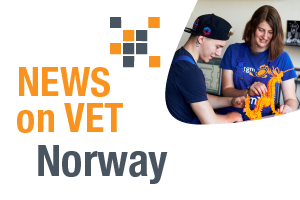At the end of 2021, the report Dimensioning of the education system was published, pointing out the reasons for the skill mismatch which currently exists in the Norwegian labour market: many companies face the challenge of finding enough qualified applicants for their posts.
Background
Lower secondary graduates are entitled to free upper secondary education. Vocational education and training (VET) programmes consist of 2 years of theoretical training (responsibility of the county authorities) and 2 years of practical training (apprenticeship; responsibility of enterprises). Learners must apply for an apprenticeship place; if not accepted, they cannot complete their education. Applicants for upper secondary programmes need to apply and indicate their top three choices; learners have ‘the right’ to be accepted in one of those upper secondary programmes. When deciding on how many school places of the different programmes to offer in a certain area, the county authorities consider the number of young people living in the area, travel time and access to apprenticeships.
Reasons for the skill mismatch
The report points out that the learners’ right to follow one of top three upper secondary programmes they applied for is one reason for this skill mismatch, as county authorities grant most learners their first choice, thereby placing applicants’ wishes over society’ needs.
The geographical dispersion of the small Norwegian population is another reason mentioned in the report. Schools offering the desired programme may be far from where a learner lives and, as young people prefer living at home while following upper secondary education, the distance of the school affects their choice of programme.
A third factor is the learners' likelihood of completing the VET programme, in which apprenticeship is key and depends on enterprises taking them on. The learners’ grades are the number one factor influencing their completion rate, as those with poor grades risk not securing an apprenticeship, and therefore, will not be able to complete their VET programme. Getting more learners with better grades into vocational education would increase their completion rate.
The completion reform
The report Dimensioning of the education system, along with other official reports, are the basis for implementing the completion reform ‘With open doors to the world and the future’ (White Paper 21; 2020-21). The reform aims to ensure that 9 out of 10 learners complete and pass upper secondary education in 2030. It will address many of the challenges identified, such as further adapting vocational programmes to the ongoing changes of skills needed, improving the county authorities’ knowledge base and room for manoeuvre in matching skill supply and demand, and ensuring the right to an apprenticeship placement.
Read more
- Dimensjonering av utdanningstilbudet [Dimensioning of the education system, in Norwegian only].
- Framskrivinger av arbeidsstyrken og sysselsettingen etter utdanning mot 2040 [Projections of the workforce and employment by education towards 2040, in Norwegian only].
- Bedriftsundersøkelse 2020 [Business survey 2020, in Norwegian only].
- Fullføringsreformen – med åpne dører til verden og fremtiden [Completion reform – with open doors to the world and the future, White Paper 21 (2020-2021), in Norwegian only].
- NHOs kompetansebarometer 2020 [Confederation of Norwegian Enterprise (NHO) competence barometer 2020, in Norwegian only].
| Please cite this news item as: ReferNet Norway; Cedefop (2023). Challenge of matching skills with labour market needs. National news on VET |
